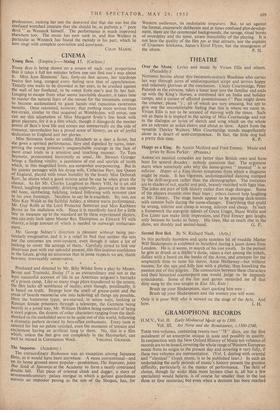GRAMOPHONE RECORDS
H.M.V., Vol. II. Early Mediaeval iVjusic up to 1300.
Vol. III. Ars Nova and the Renaissance, c.1300-1540.
THESE two volumes, containing twenty-two "78" discs, are the first instalment of an enterprise unique in scale and possibly in quality. In conjunction with the New Oxford History of Music ten volumes of records are to be issued, covering the whole range of Western European music from its origin to the present day and covering it very fully, if these two volumes are representative. (Vol. I, dealing with oriental and "classical" Greek music, is to be published later.) In such an undertaking the early periods of music's history present the greatest difficulty, particularly in the matter of performance. The field of choice, though far wider than most laymen (that is, all but a few specialists) would believe, is of course far smaller than in the last three or four centuries; but even when a decision has been reached as to what to include as typical, the chief difficulty still remains—how the music chosen is to be presented. Obviously historical accuracy must be the chief consideration in a series planned as practical illustration of a scholarly text; but, since our forefathers were so sparing in their instructions and musical notation in its early stages demanded a knowledge of tradition without which it is often ambiguous, each of several different methods of performance has a claim to be considered historically accurate. In his foreword to the booklets published with each volume the general editor, Professor Abraham, states expressly that the interpretations offered in these records "are not claimed as the only correct ones, but are ... suppor- ted by a weight of authority and give an impression as accurate as at present possible of the actual sound of the music of past ages." What will that impression be in the case of the ordinary musical but merudite listener? What will he make of Byzantine and Gregorian chant, troubadour song and the first clumsy attempts at polyphony in the first volume; or the growing elaboration of French and English liturgical music, the early sixteenth-century Netherlanders, the Burgundian chansons and the first examples of a genuinely instru- mental style in the second? Liturgical music is really only appreciable, perhaps only wholly intelligible, in its place• as one—not the most important—element in liturgical worship; and for the average modern listener this demands an effort of the imagination and a certain amount of rudimentary knowledge and sympathy which will not be universal. Yet this is not really a specialist's preserve, merely "historically interesting" music. Those who can appreciate the architectural beauties of Romanesque and Gothic cathedrals should surely be able, with a little trouble, to enjoy their musical counterparts. Early secular music seems rough and primitive compared with the dignified eloquence of Gregorian chant and the formal intricacies of the early polyphonic masterpieces. But there are a freshness, simplicity' and spontaneity about some of these love- songs and short instrumental pieces which are immediately appealing to anyone prepared to forget the sonorous splendours to which our ears are accustomed.
These records, then, though of enormous practical value to scholars and students—who will be grateful for the musical texts printed in the booklet issued with each volume—contain a great deal to interest and entertain any amateur whose taste is at all adventurous. The standard of performance is high. The recordings by our own Schola Polyphonica, Brompton Oratory Choir, Bodley and Renais- sance Singers, the Belgian Pro. Musica Antigua Ensemble and the Swiss Schola Cantorum Basffiensis are what is generally called "authoritative." That is to say, they carry conviction to the
i
listener, even when the music s of an unfamiliar kind, and give the impression of a certainty and unity of style. Some of the solo songs do not quite carry conviction, partly perhaps because the old French, German and English texts .cannot avoid sounding odd and archaic, and because our ears associate a single vocal line either with liturgical music or folk-song. But all in all this is a wholly praise- worthy and admirable undertaking, and it is ungenerous to carp at minor flaws, some of which may well be in the listener's ear.
A confusion of labels on the last two discs of the second volume may mislead those who follow the music in the text and should be



































 Previous page
Previous page